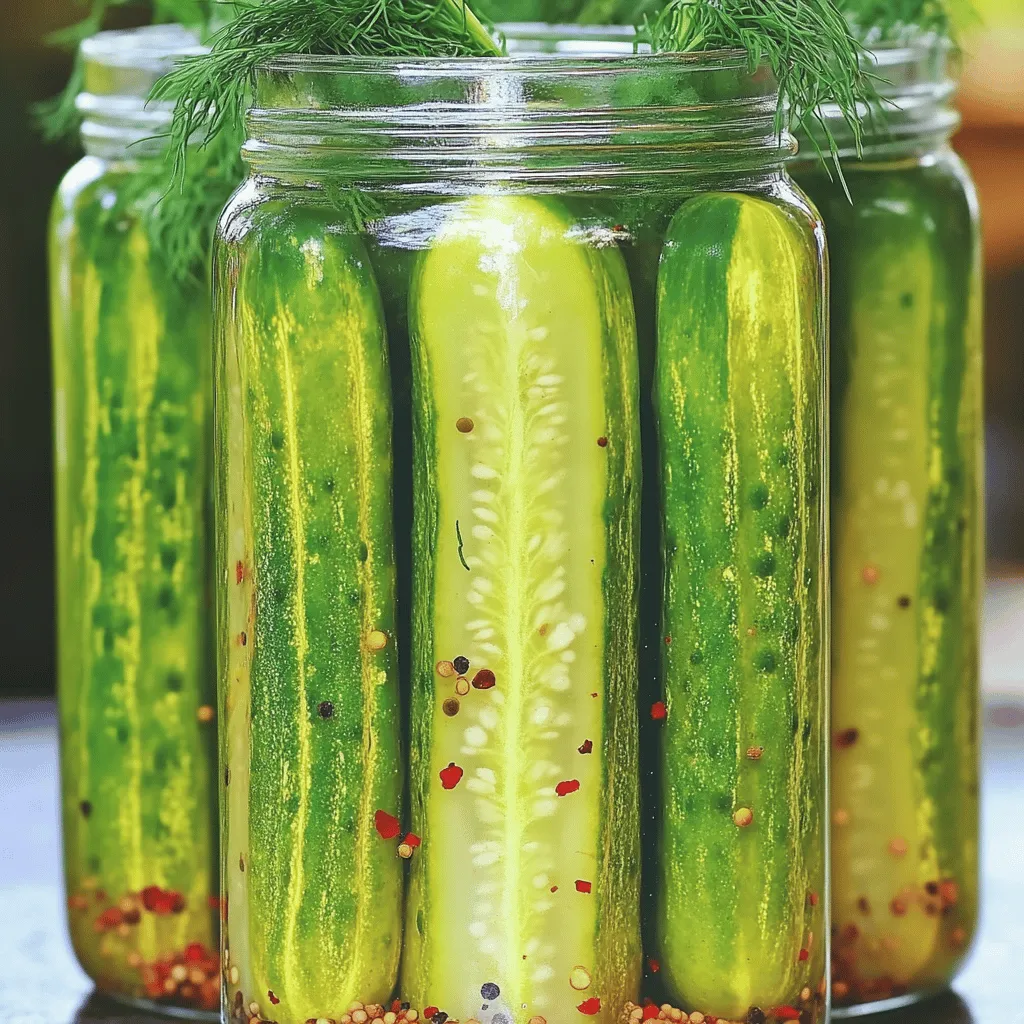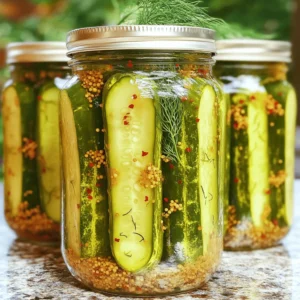Are you ready to make crunchy pickles at home? This guide shows you how to create tangy, flavorful pickles that stay crisp and delicious. With just a few simple ingredients and easy steps, you’ll be enjoying homemade pickles in no time. From selecting the right cucumbers to mastering the brine, I’ll cover everything you need to know. Let’s dive into the pickle-making process that will impress your friends and family!
Ingredients
Main Ingredients
– 4 cups small cucumbers (pickling cucumbers are best)
– 2 cups water
– 1 cup white vinegar
– ¼ cup sea salt
– 1 tablespoon sugar
Flavoring Ingredients
– 3 cloves garlic, crushed
– 2 teaspoons dill seeds
– 1 teaspoon mustard seeds
– ½ teaspoon red pepper flakes (optional, for a spicy kick)
Garnishing Ingredients
– Fresh dill sprigs for garnish
When making crunchy pickles, the right ingredients matter. I always choose small pickling cucumbers. They give the best crunch and flavor. You need white vinegar and water to create the brine. Sea salt is key for flavor and texture. Don’t forget the sugar; it balances the tartness.
For flavor, I love adding garlic and dill seeds. They enhance the pickles’ taste. If you like a kick, add red pepper flakes. Mustard seeds also bring a nice tang.
Finally, fresh dill sprigs are great for garnishing. They add a pop of color and more flavor. This combination makes your pickles not just crunchy but also delicious.
For the full recipe, check out my Crunchy Dill Pickle Delight.
Step-by-Step Instructions
Preparing the Cucumbers
First, wash the cucumbers well. This step is key to keeping them clean. For extra crunch, soak them in cold water for two hours. This helps pull moisture out of the cucumbers. Next, cut off the blossom end. This part can cause pickles to soften, so don’t skip it.
Making the Brine
Now, let’s make the brine. In a medium saucepan, combine the following ingredients:
– 2 cups water
– 1 cup white vinegar
– ¼ cup sea salt
– 3 cloves garlic, crushed
– 2 teaspoons dill seeds
– ½ teaspoon red pepper flakes (optional)
– 1 teaspoon mustard seeds
– 1 tablespoon sugar
Bring the mixture to a boil over medium heat. Stir until the salt and sugar dissolve. Once boiling, remove it from heat and let it cool to room temperature.
Packing the Jars
While the brine cools, you can prepare the jars. Sterilize glass jars by placing them in boiling water for a few minutes or running them through the dishwasher on high heat. Once they cool, pack the cucumbers vertically into the jars. Add fresh dill sprigs between the layers; this adds flavor and looks nice.
Pouring in the Brine
Carefully pour the cooled brine over the cucumbers. Make sure they are completely submerged. Leave about ½ inch of headspace at the top of each jar to allow for expansion.
Sealing and Storing
Wipe the rims of the jars with a clean cloth. Seal the jars with sterilized lids. Let them cool to room temperature before placing them in the refrigerator. This helps create a better seal.
Pickling Process
Now, it’s time for the pickles to develop flavor. Let them sit in the fridge for at least 48 hours. This waiting is important for achieving that crunchy texture. The flavors will deepen over time, so be patient! You will be glad you waited.
For the full recipe, check out Crunchy Dill Pickle Delight!
Tips & Tricks
Achieving Crunchy Texture
To make crunchy pickles, follow these simple steps. First, soak your cucumbers in cold water for two hours. This helps them stay crisp. Next, use pickling salt instead of table salt. Pickling salt dissolves well and keeps the pickles crunchy. Always choose fresh, high-quality cucumbers. Fresh cucumbers have better texture and flavor.
Troubleshooting Soft Pickles
Soft pickles can happen for several reasons. One common mistake is not soaking cucumbers enough. Always soak them for at least two hours. Another issue is cutting off the wrong end. Make sure to cut the blossom end off to help keep your pickles firm. If your pickles still turn soft, try adding a few grape leaves to the jar. Grape leaves contain tannins that help keep pickles crunchy.
Enhancing Flavor
To make your pickles even better, you can play with spices and herbs. Dill seeds and garlic are classic, but you can add others too. Try adding black peppercorns or coriander seeds for a twist. For a unique kick, consider adding a splash of horseradish. These small changes can create exciting new flavors in your pickles.

Variations
Spicy Dill Pickles
To make spicy dill pickles, you can easily add extra red pepper flakes. This small change gives your pickles a nice kick. You might also try adding sliced jalapeños or other hot peppers. Both options make a tasty treat for those who love heat.
Sweet Pickles
If you want sweet pickles, just alter the sugar in the recipe. Adding more sugar will give them a nice sweetness. You can also mix in spices like cinnamon or cloves for a unique flavor. This way, you can create sweet pickles that are perfect for snacks or sandwiches.
Cucumber Size and Types
Different cucumber varieties can change your pickle’s taste and crunch. Pickling cucumbers work best for that satisfying crunch. If you use larger cucumbers, you may need to adjust the brine. Slice them thinner to ensure they soak up the flavors well. Always tailor your technique based on the cucumber size to get the best results.
For the full recipe, refer to the Crunchy Dill Pickle Delight section.
Storage Info
Refrigerator Storage
You can keep your crunchy pickles fresh in the fridge for about two months. I recommend using glass jars with tight-fitting lids. This helps to lock in flavor and crunch. Make sure the pickles remain submerged in the brine to stay crisp.
Long-term Storage Options
For shelf-stable pickles, consider canning. This method allows you to store pickles for up to a year. Use a water bath canning method for best results. You can do this by filling a large pot with water and bringing it to a boil. Place your sealed jars in the boiling water for about 10 minutes. Let them cool completely before storing them in a cool, dark place.
Recognizing Spoiled Pickles
Always check for signs of spoilage. If your pickles are cloudy or have an off smell, they may not be safe to eat. Look for bubbles or any signs of mold on the surface. If you notice any of these signs, it’s best to throw them out. To ensure safety, always taste a small piece before consuming. If it tastes off, do not eat it.
FAQs
How long should pickles sit before eating?
You should let your pickles sit for at least 48 hours. This time allows the flavors to mix well. The longer they sit, the better they taste. After a week, they reach their best flavor. So, patience is key!
Can I use regular cucumbers instead of pickling cucumbers?
You can use regular cucumbers, but pickling cucumbers are better. Pickling cucumbers are smaller and crunchier. They hold up well in brine. Regular cucumbers might turn soft and mushy. Choose pickling cucumbers for a crispier bite.
What causes pickles to turn soft?
Soft pickles can happen for a few reasons. Using old cucumbers or not soaking them first can lead to softness. Also, not using pickling salt may cause issues. Pickling salt helps keep the crunch. So, always use fresh cucumbers and the right salt.
How to extend the shelf life of homemade pickles?
To extend shelf life, store pickles in the fridge. Use clean, sterilized jars to prevent bacteria. Ensure the cucumbers stay submerged in brine. You can also can your pickles for long-term storage. This method keeps them fresh for months.
Can I reuse pickling brine for future batches?
Yes, you can reuse pickling brine. However, it’s best to do this once. After one use, the brine can lose flavor. Strain out any bits of food before reusing. Always check for any off smells or colors before using old brine.
Making pickles at home is simple and fun. We covered key ingredients, from cucumbers to seasonings. You learned how to prepare, pickle, and store your crunchy creations. Remember to soak your cucumbers for extra crunch and use the best ingredients available. Experiment with flavors and variations to find your perfect pickle. With patience and practice, DIY pickling can bring joy to your kitchen and enhance your meals. Enjoy your pickling journey and savor the flavors you create!

